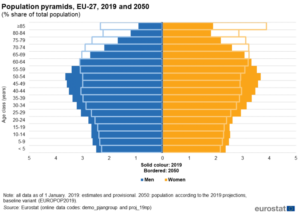In recent decades, the global population has been experiencing a significant demographic shift characterized by an aging population. This shift has far-reaching implications for various aspects of society, including the labor market. As an employer, understanding the dynamics of an aging population and its influence on the workforce is crucial for adapting to this evolving landscape.
In this article, we will explore the meaning of an aging population, its impact on the Belgian labor market, and provide valuable tips for employers to effectively navigate this demographic change.
Understanding an Aging Population
An aging population refers to a situation where the proportion of older individuals (typically aged 65 and above) increases relative to the younger population.
How does it look like in the European age pyramid?

(source: eurostat)
The base is narrower and will continue to shrink by 2050. Indeed, the median age of the European population will reach 48.2 years by 2050 (vs 43.7 in 2019).
This demographic phenomenon arises from several factors, including declining birth rates and improvements in healthcare leading to increased life expectancy.
The working-age population, defined as individuals between 15 and 64 years old, undergoes a relative decline compared to the elderly population, leading to an increase in the old age dependency ratio. This ratio measures the number of individuals aged 65 and above relative to the working-age population.
Impact on the Labor Market
As you can imagine, this change has considerable impacts on the job market, and therefore on recruitment.
Shrinking Talent Pool
With a declining working-age population, employers face a smaller pool of available talent. Today, the market is already tight due to a growing economy (+3.2% in 2022), the rapid development of new technologies, with companies hiring more and more, and talent well aware of their value.
If you add to this an aging population, and therefore fewer people of working age, the tension only increases.
Skill gap
As older workers retire, they often take with them years of experience and specialized knowledge. For companies that do not have a recruitment plan, many employees may retire in 5 years without having transferred their knowledge to the younger generation. That’s a big risk. This knowledge gap poses a challenge for employers who need to find ways to transfer valuable expertise to the younger workforce.
Along with this demographic change, we are also witnessing a major shift in the work landscape. With digitalization and rapid technological changes, many professions are disappearing, and others are emerging. According to a study from Dell and The Institute for the Future, 85% of the jobs that will be performed in 2030 do not exist today.
These new professions bring with them their share of new skills. This phenomenon is so fast that training courses are struggling to keep up with the trend. In addition, the older part of the workforce is not digital native, which can make the task of keeping up even more difficult.

Increased labor costs
The aging population can exert upward pressure on labor costs as the demand for workers surpasses the supply. The competition for talent can result in higher wages and benefits, affecting a company’s profitability.
Changes in workforce dynamics
An aging population brings a shift in workforce dynamics, as younger generations may be required to work longer or fill the gaps left by retiring workers. The next generations will be aware that they will probably have a longer career, and this may result in a change in their needs and expectations.
Rising healthcare expenses
As the elderly population grows, healthcare costs tend to increase. Employers may face higher expenses related to employee healthcare and benefits, affecting their overall cost structure.
Strategies for employers
Those situations are not inevitable and are perhaps an opportunity to consider recruitment differently. Here are 5 tips to tackle these challenges:
Embrace age diversity
Recognize the value of a multigenerational workforce and create an inclusive work environment that accommodates the needs and aspirations of employees of all age groups. The benefits of mixing different age groups are multiple for your company:
Various perspectives: It’s not a secret that senior and younger workers might have very different opinions, especially in terms of technology use and related topics. It’s interesting to consider both perspectives. The more insights, the more informed the decision-making process.
Meaningful interactions: In our daily lives, we are often in contact with people of our own age. This reflex comes from school and extracurricular activities where we shared our days with peers. Alongside older (or younger) people, we can enjoy a different view of life and advice. It’s great to see people from different generations, with maybe different opinions, learning from each other
Knowledge sharing: By creating age-diverse teams, you avoid the skills drain.

Focus on skills development
You have to invest in training and development programs to enhance the skills of your existing workforce.
By training the younger employees, you ensure that the skills are perpetuated, regardless of the presence of an older workforce. Conversely, training your older workforce allows you to offset the talent war that is going on with younger talent.
Prepare for the future and train your employees on emerging technologies. Your older employees may be reluctant to embrace the digitization of their daily work. It is therefore key to make them aware of how technology can help them in their work and not replace them.
Flexible work arrangements
Offer flexible work options such as remote work, flexible hours, and part-time opportunities.
These arrangements can attract older workers seeking a phased retirement or individuals with caregiving responsibilities but also the younger workforce that sets flexibility high on their expectations’ shortlist.
Establish a succession plan
With a large portion of the workforce set to retire, it is key not to get caught off guard and establish a clear recruitment plan for the coming years. Whether you decide to grow your talent internally or recruit new people, you should plan ahead and be able to launch each hire on time. If you consider internal mobility, see point 2. 👆
Also, make sure that the person being replaced can cross-pollinate with his or her successor to ensure a smooth and fluid handover, with an assured transfer of skills.
Collaborate with educational institutions
Foster partnerships with educational institutions to shape curricula and create programs that align with the evolving needs of the labor market. Your company can engage in internships, apprenticeships, and co-op programs to attract young talent.
The student workforce is a real gold mine. You can share your knowledge, your way of working, train them to your products/services, with the objective of bringing them to the potential necessary to be hired.
Promote health and well-being
Implement wellness programs and initiatives to support the physical and mental well-being of employees across all age groups. This can contribute to increased employee satisfaction, productivity, and reduced healthcare costs.
Tap into experienced talent
Although a large portion will soon be retired, older employees represent a significant part of the workforce today. In 2019, people aged 55 or older already represented 33.6% of the total EU population (source: eurostat).
It is therefore key to consider them when hiring. We don’t need to remind you how experienced this workforce is and how much it can help your younger employees.
Besides their deep knowledge, hiring senior workers is also a responsible and citizen act. When a person is laid off at age 50+, they are in a very difficult situation. Too young to retire, too old to be hired. And unfortunately, they sometimes find themselves forced to retire prematurely, increasing the number of retired people.
We must therefore do our best to minimize the number of people retiring too early. To do this, the labor market must be welcoming from age 18 to age 65.
Considering the fact that workers are increasingly mobile and spend less and less time in one company, it is all the more ridiculous to exclude the older workforce. Why not take full advantage of a worker’s enormous expertise for another 4 or 5 years before they retire?

In conclusion…
Addressing the challenges posed by an aging population in the labor market requires proactive measures and innovative strategies from employers. By understanding the implications of demographic shifts, embracing age diversity, and implementing targeted initiatives, employers can position themselves for success in an evolving and dynamic workforce landscape. Embracing the opportunities presented by an aging population can lead to increased productivity, knowledge sharing, and a more inclusive work environment.
By adapting and implementing the tips outlined in this article, employers can proactively navigate the changing labor market dynamics, attract (need some help?) and retain top talent, and foster a thriving organization in the face of an aging population.